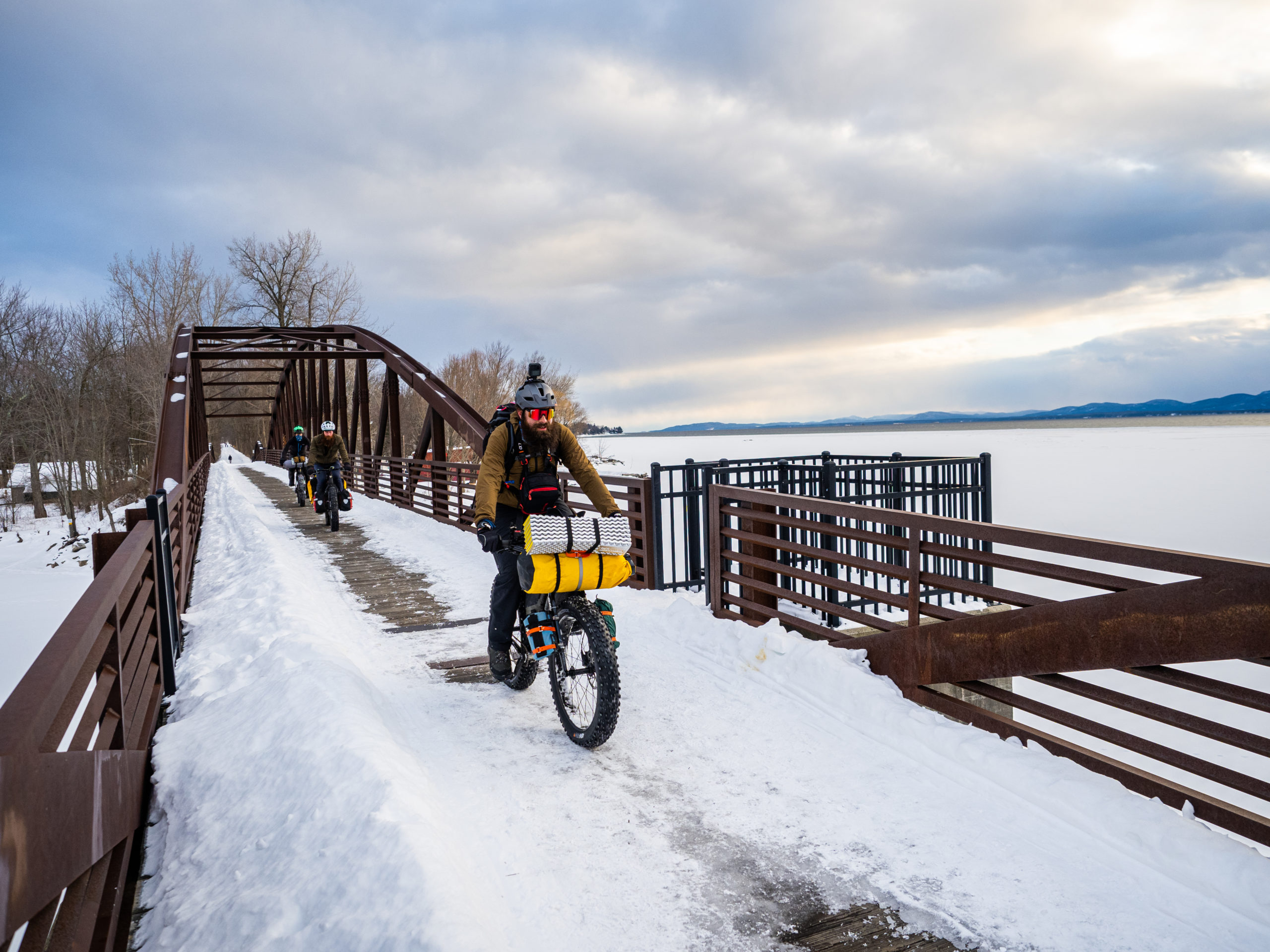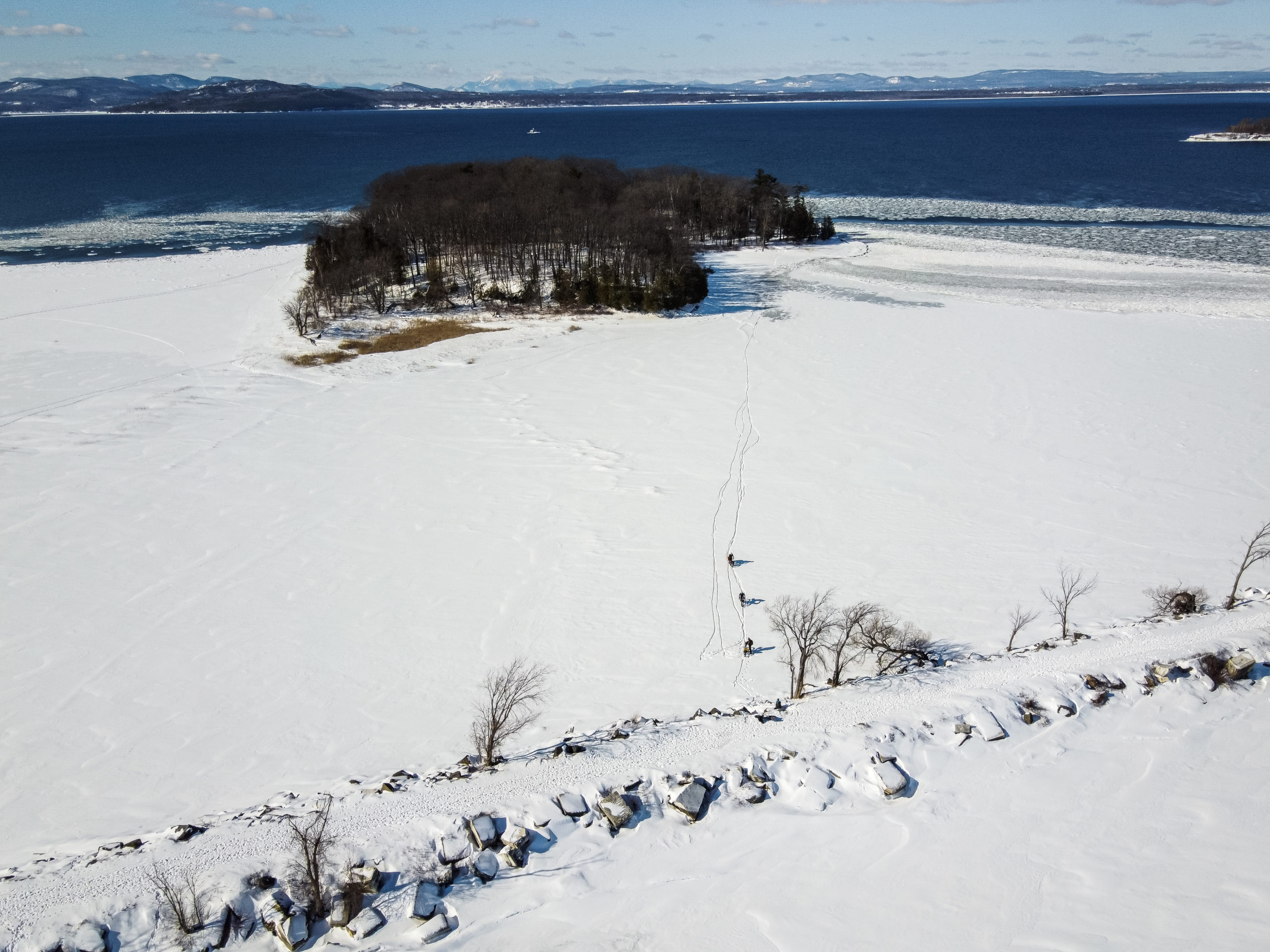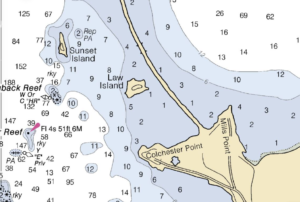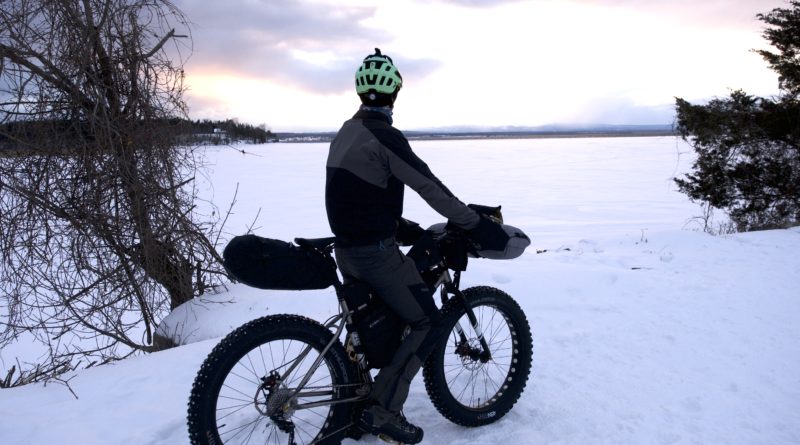Fat Bikes and Island Camping
Eds. note: to see what Greg Maino and his friends packed for this trip and the gear they carried, see How to Pack for a Winter Bikepacking Trip
For a long time, I struggled to wrap my head around fat biking and couldn’t understand why anyone was drawn to it. I consider myself an outdoor generalist; for me, winter was for alpine or Nordic skiing, backcountry skiing, snowshoeing and ice climbing. It was a time to do all of the things you couldn’t at other times of the year.
If you’re not familiar with fat biking, it’s basically mountain biking on a heavy bike with really wide tires, but colder, and slower. Here in the Northeast, the best places to fat bike are frozen dirt roads, Nordic centers and snowmobile trails (if permitted)—and on a growing network of trails groomed specifically for fat biking. In my short time as a fat biker I’ve found it’s a lot of work, and is most enjoyable in a relatively narrow range of conditions. It can’t be too warm, or too cold. The surface needs to be firm, but not too soft or too icy (unless you have studded tires!). Things have to be just right.
Additionally, the extra wide tires found on fatbikes aren’t as magical as many non-fatbiking bikers might believe. Before I started, I had visions of floating across powdery fields, monster-trucking over rugged terrain, and cruising effortlessly through Vermont’s wintery woods suspended on massive, rubbery floatation devices. However, the reality is that taking a fat bike out for some fresh air often requires some amount of walking, pushing, lifting, and dragging. Don’t get me wrong, it’s fun, but outings often veer into Type 2 territory.
It should also be known that I’m currently in the middle of experiencing my first season of fat biking, and my perspective isn’t comprehensive. With that said, you might now be wondering why someone like myself is even writing about fat biking. Well, I’m writing because fat bikepacking is amazing!
So, how did I get from there to here?

Fat Bikepacking
It started with a pandemic that shut down the world and cut us off from our family, friends, and neighbors. I’m not someone who travels a lot, but I do get around. I started getting into bikepacking a couple of years ago, but this past summer I really caught the bug due to our inability to travel any significant distance away from home.
Bikepacking, which is what you get when you combine backpacking and cycling, allowed me to load up my bike and go have an adventure right from home. It provided a new lens through which to view my backyard, and half the fun was trying to find new places to camp, and figuring out how to connect everything in an interesting way. During a period when we were all feeling very confined, bikepacking provided a much needed, Covid-safe way to escape.
So how does fatbiking fit in? As fall approached, and it became apparent the pandemic was not going away, I started thinking about what my winter was going to look like. Typically, I’d be skiing a lot, but with all of the new protocols and uncertainty at the ski resorts I knew I didn’t want to mess around there. So, after a lot of deliberation, I decided to pull the trigger and purchase a fatbike. My reasoning was that I could use it to commute to work, trail riding opportunities were more convenient than skiing opportunities, and it would allow me to continue bikepacking through the winter. Also, ever since reading a story about fatbike camping in Groton State Forest in Vermont Sports I’ve wanted to give it a go myself.
It’s now the middle of February and I’ve learned a couple of things. My winter commuting route is sketchy no matter what bike I ride, and fatbiking is much more than a short-term holdover during a pandemic winter. It’s actually incredibly fun, and has helped me better use my time outside this season. I have two young kids at home, so free time is in short supply. During the winter I used to run when time was short, and ski when a larger window was available. However, I often had more time than I could use running, but not enough to go skiing. Now, thanks to a few conveniently located trail systems, I have fat biking to fill what used to be an awkward stretch of time. Winter was also a period when sleeping outside was put on hold, but now I have fat bikepacking.
This season, I enjoyed riding the trails near Burlington (Mud Pond, Chamberlain Hill, Burlington’s Wildways, and the Catamount Outdoor Family Center). It’s a different experience from summer trail riding. It was quiet, beautiful, required a different kind of balance and precision, and was a freaking great workout. Starting in January I also did a number of fat bike-nabled overnights. The last of which was a linkup of Burlington’s Wildways, the Burlington Bike Path, and an island on Lake Champlain.

Island Camping
Law Island, a small island on Lake Champlain north of Burlington and just off the Colchester Causeway, has been on my list for a while. A 9-acre island owned by the Lake Champlain Land Trust, it has primitive campsites and great views west for sunsets. Being only 8 miles away from downtown Burlington on the bike path, Law Island offered a great opportunity for a snack-sized, adventurous backyard excursion. However, it is an island which means it’s surrounded by water. Fortunately, during winter, sometimes that water is frozen. The island is less a quarter mile from the causeway and the water leading out to it is shallow—only a foot deep in most places.
For months I watched the weather and consulted experts on the ice conditions. After watching the weather for weeks, and double-checking to ensure there was adequate ice between the causeway and the Island, we put our plan into action. I was joined by three friends—Rob Stumler, Brennan Guerriere and John Ware. We packed
up our bikes, and late on a Saturday afternoon we met in Burligton’s Old North End and got after it.
To up the ante a bit we included trails at the Intervale Center, McKenzie Park, Ethan Allen Homestead, and Ethan Allen Park in addition to the Burlington Bikepath as part of our route. These trails are part of the Burlington Wildways Partnership, an effort to protect and connect Burlington’s natural areas.
We pedaled through backroads and side streets until reaching the Intervale Center, a 360-acre farm and trail system situated along the Winooski River. Here, we were able to leave the roads and take to the trails, enjoying snowy woods and riverside views before jumping back onto the roads briefly in Burlington’s New North End. There was a bit of bike pushing along the way. But, as I mentioned previously, walking your bike is just part of the fat bike experience, especially when loaded down for winter camping.
After exiting the trails at Ethan Allen Park, it was a quick hop to the Burlington Bike Path. From there we enjoyed 5.5 miles of easy cruising on well-packed snow along the shores of Lake Champlain. We followed the bike path over the bridge at the mouth of the Winooski River, and out onto the Colchester Causeway which divides Mallets Bay and Lake Champlain. Once on the causeway we continued out until we were just across from Law Island. We then made our way down to the ice and crossed over, being careful to take as direct of a route as possible in order to minimize our time on the ice and minimize any risk of falling through.
Caution is always required when venturing out onto frozen water. We had been tracking ice conditions around Law Island all winter long and had researched water depths in the area. Additionally, we scouted the area in-person prior to our trip.
 Once safely across, we used the last bit of light to locate a place to camp and settled in. After preparing our beds and changing into dry clothing, the next priority was fire. Winter nights in Vermont can be long and cold, and having a fire provides light, warmth, and a place to gather and socialize. Being in the company of such good people, it was well past midnight before we realized we were cold and retreated to the warmth of our tents and sleeping bags. Despite being just a few miles from the heart of Burlington we felt a world away.
Once safely across, we used the last bit of light to locate a place to camp and settled in. After preparing our beds and changing into dry clothing, the next priority was fire. Winter nights in Vermont can be long and cold, and having a fire provides light, warmth, and a place to gather and socialize. Being in the company of such good people, it was well past midnight before we realized we were cold and retreated to the warmth of our tents and sleeping bags. Despite being just a few miles from the heart of Burlington we felt a world away.
The next morning, we woke up with the sun, filled our bellies with warm food, explored the island, then packed up. I had a family to get back to, and the others had things to do and places to ski. Fortunately, a quick trip on the bike path was the only thing standing between us and home.
Spending time outside is good for you. It boosts your immune system, improves mental function, increases your metabolism, and just makes you happier. In less than 24 hours we exploited all of these benefits while filling our adventure cups and deepening our connections with each other, and it was all made possible by slow, heavy bikes with really big tires.

